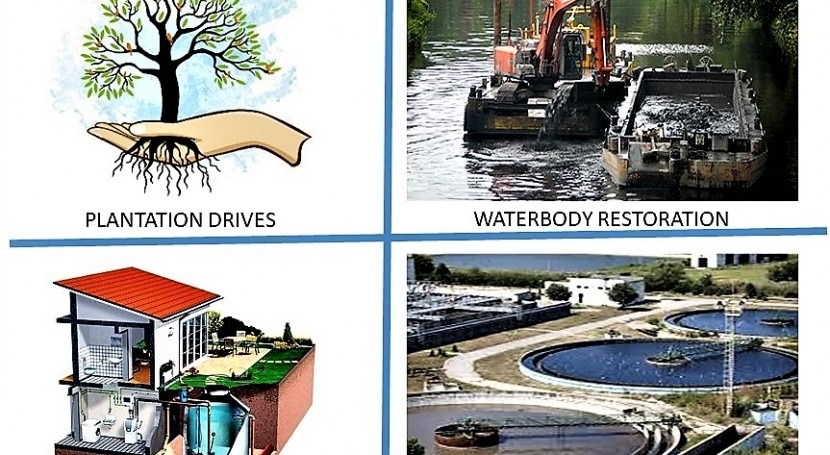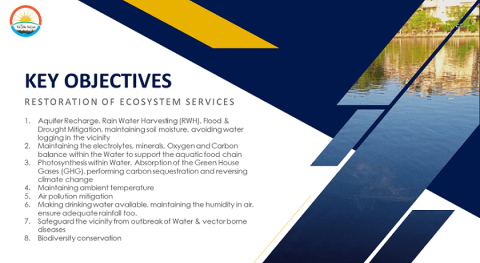Today, let’s focus on what couldn’t be discussed in detail in the previous blog post – verifying processes.
As discussed, by and large, across the globe people adopt four processes in the name of Water Conservation, which are listed below;
i) Rain water harvesting – collecting and dumping water in the ground, so that it gets soaked and helps enrich the underground aquifer.
ii) Plantation drives – planting more and more trees towards creating a greener planet.
iii) Restoration of waterbodies - so as to make drinking water available, and last but not the least;
iv) Sewage treatment plants – so that sewage (which is 95% fresh water) could be reused reducing the extraction of more underground water.
Now let’s analyse one by one:
1- Rain water harvesting – before we attempt to understand the reasoning behind failure of this process, it is important to know the forces of nature that would make it happen.
There are two key things we should keep in mind in order to understand this phenomena. One is the underground aquifer while other is the soil moisture. Both are water, but the former is below the soil, while the latter is within the soil.
When we say harvesting, the basic idea is to be able to use it later. Now both are used in different ways. The soil moisture is used by the plants to grow and the underground aquifer is the water that we humans take out for our usage through borings and tube wells.
The basic apparatus that we install for rain water harvesting are pipelines from the rooftops of buildings to a pit installed with a tank with holes in the side walls. Now when the rain water comes in to this tank through pipelines, it gets leaked and absorbed by the soil around the holes, and contributes to the soil moisture, but it can never reach the aquifer below raising the water table. Thus the idea of recharging fails.
But it does help in increasing the soil moisture. That is the reason why, all plantation drives succeed in the regions where rain water harvesting is done successfully. This brings us to the second method;
2- Plantation drives – the idea is indeed wonderful from the perspective of dealing with air pollution, because plans essentially produce oxygen and make air fresh for all aerobic beings like humans to breathe better.
But how on earth will plants help in water generation? Especially when we all know that plants are consumers of water, not the producers?
That is why plantation drives fail when there is no provision for adequately watering them, because in our quest for economic growth, we’ve spoiled the ecology in soil, water and air that was sufficient for growing all the plants in any particular agro-climatic zone. With excessive chemicals in our routine life, agriculture and smoke emissions – we mixed chemicals everywhere, resulting in the death of ecology.
3- Restoration of waterbodies – these surface waterbodies have been the natural rain water harvesting apparatuses from the ancient world. But we’ve spoilt them to the extent that they are no longer effective.
We did it with sludge. Today we’ve made water as the de-facto waste transport medium. All the waste and dirt is washed away with water be it on cars or clothes, dishes to dandruff, everything is washed by water, converting water to sewage. All sewage on the planet is 95% fresh water and only 5% of solid waste that we’ve added through anthropogenic activities.
So we got this idea of separating sludge from sewage and making it fresh again – voila!! What an idea, isn’t it? But that’s just a half cooked idea. What will we be doing with that sludge? Make compost or put it in a landfill?
It is only we humans who generate waste and we are even possessive about our waste, we even want to preserve it. In nature there is nothing called “waste”. Everything that comes out of nature goes back to nature. It is consumed.
Today, the methods that we adopt for waterbody restoration can be categorised in three domains – namely, physics, chemistry and biology.
i) Physics – This is a three step process – decantation, de-sludging and refilling. Flaws in the process include – wastage of water, sludge management hassles, disturbing the biodiversity by mechanical dredging, and wastage of time, energy and money. And in spite of all – the waterbody still remains where it was because mechanical removal of sludge can’t differentiate between sludge and silt, and without silt the aquifer recharge wouldn’t happen.
ii) Chemistry – Every chemical reaction has it own residue, to sludge remains where it was. However in quest of solving the sludge problem, we might as well kill some of the microbes as a side effect of the chemical reaction, which again will harm ecology.
iii) Biology – This is primarily done by introducing an invasive species in the ecosystem. Now this is again not a sustainable practise because we are harming ecology again. Then be it the phosphates and nitrates consuming weeds on some floating islands or be it the cyanobacteria treatment, both are foreign entities to the waterbody. Thus they act as invasive species in ecology.
The only sustainable way of waterbody rejuvenation is an ecological restoration in which sludge is consumed in the natural process, NOT removed physically, ensuring ZERO wastage. In any process we do, if we are left with any residue or waste, then it can’t be a natural process. And no artificial process can be ecological. It could be good for a stop gap arrangement, but definitely not maintainable.
Now the fourth activity that we do is practically a corollary of the third only.
4- Sewage treatment plants – here again we adopt only the above mentioned three processes, the difference is just the natural waterbody and man-made physical structure of a treatment plant, be it STP or ETP.
It’s high time for us to understand that water pollution is NOT a physical / chemical or biological problem, but rather an ecological problem.
There’s ecology in water. natural waterbodies have life in it, it is an ecosystem in which millions of beings survive. How can it be sorted in to mere chemicals? Every human body is a chemical factory that secretes chemicals based on emotion and thoughts, which means every time you do a chemical analysis you will get different results, unless the body is dead. And the same is true for water.
You don’t clean sick people, you cure them. Similarly, water needs to be cured, NOT cleaned. And the only possible way out is an ecological treatment.
Just imagine this, with your thought and emotions, you can bring in chemical, physiological and biological changes in your body, because with your thoughts and emotions you can change the chemical secretion within the body. That means you can correct your body chemistry if you have control over your mind.
The same goes for water.







